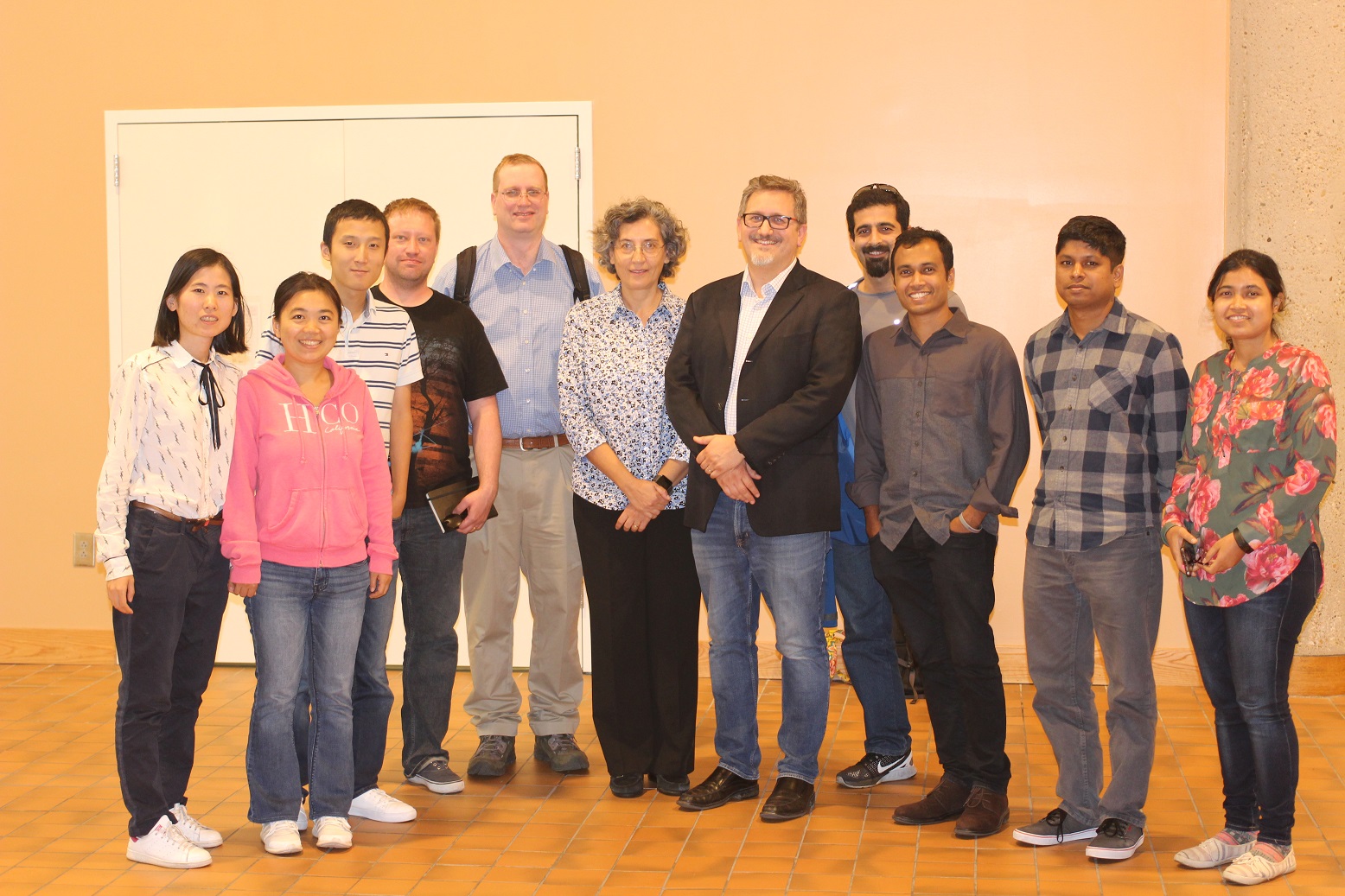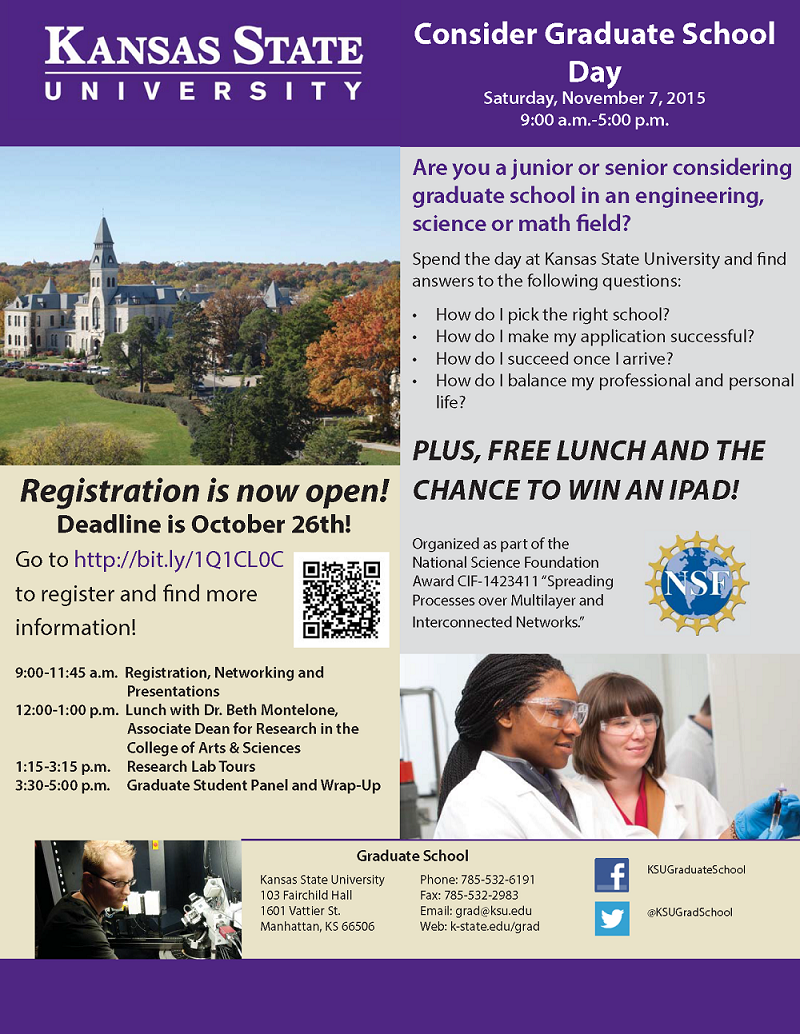Events
April 11, 2023. Today Junyao defended successfully his Ph.D. Congratulations, Dr. Kuang!
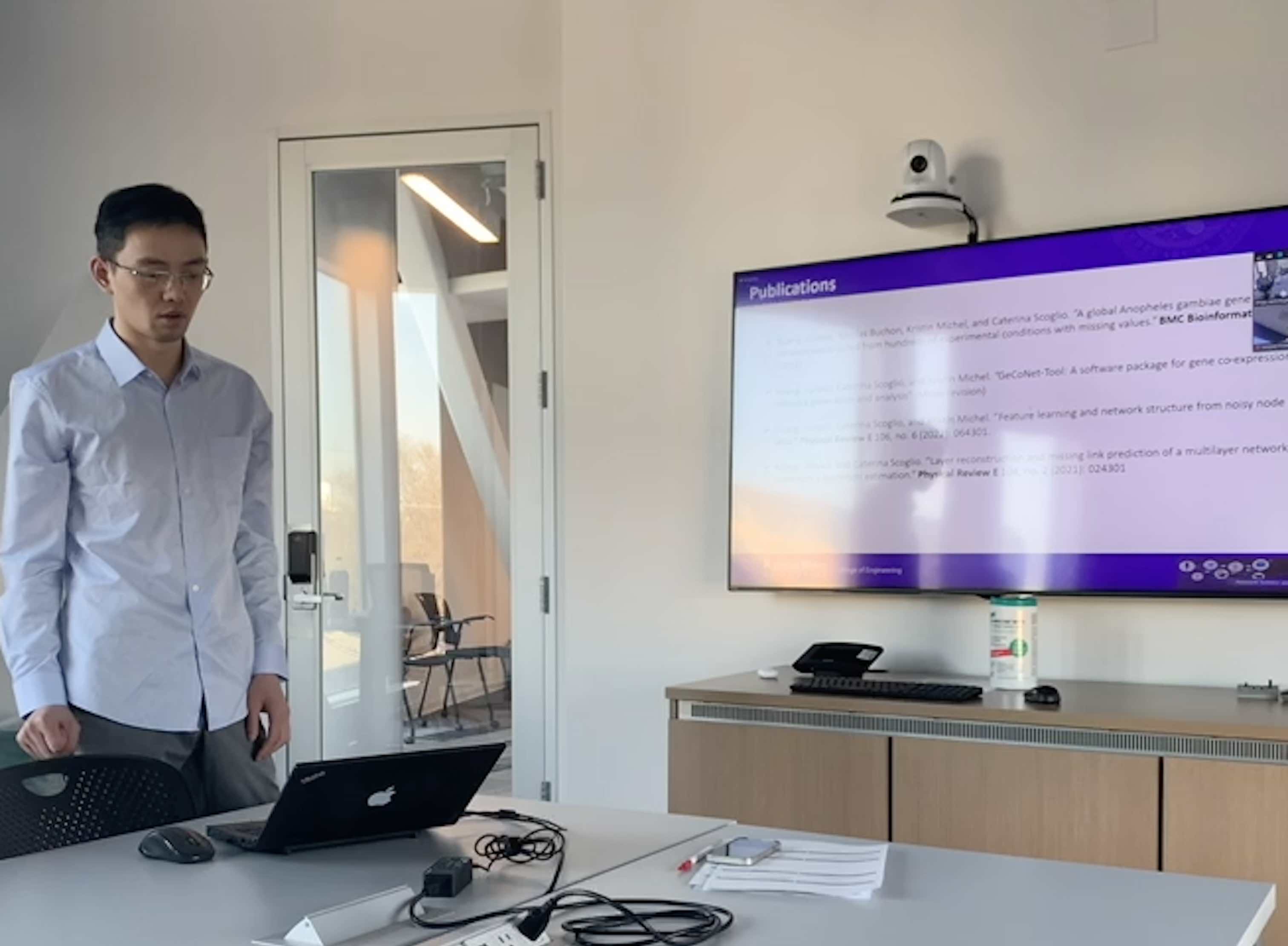
Dengue cases forecasts for current outbreak in Cambodia in collaboration with Dr. Lee Cohnstaedt
Data provided by WHO: https://www.who.int/westernpacific/emergencies/surveillance/dengue
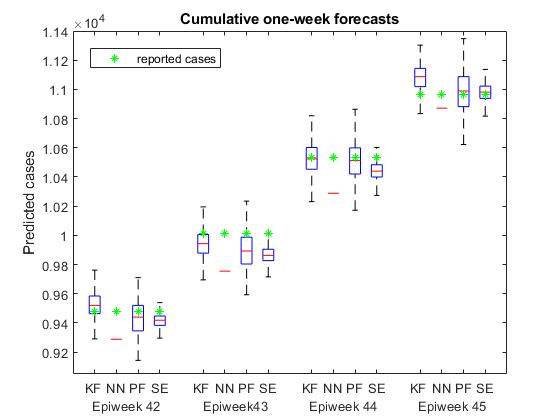
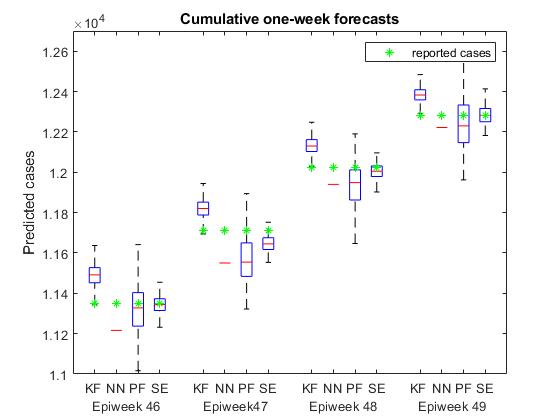


The methods applied to the forecasts are the ensemble Kalman filter (KF), the recurrent neural network (NN), the particle filter (PF), and super ensemble (SE), which is a combination of the three previous methods.
The green * are the real number of cases in that epiweek and the boxplots are the corresponding forecasts. The last group of boxplots is the current forecasts and the official number will be reported in https://www.who.int/westernpacific/emergencies/surveillance/dengue.
July 21, 2020. Today Riad defended successfully his Ph.D. Congratulations, Dr. Riad!
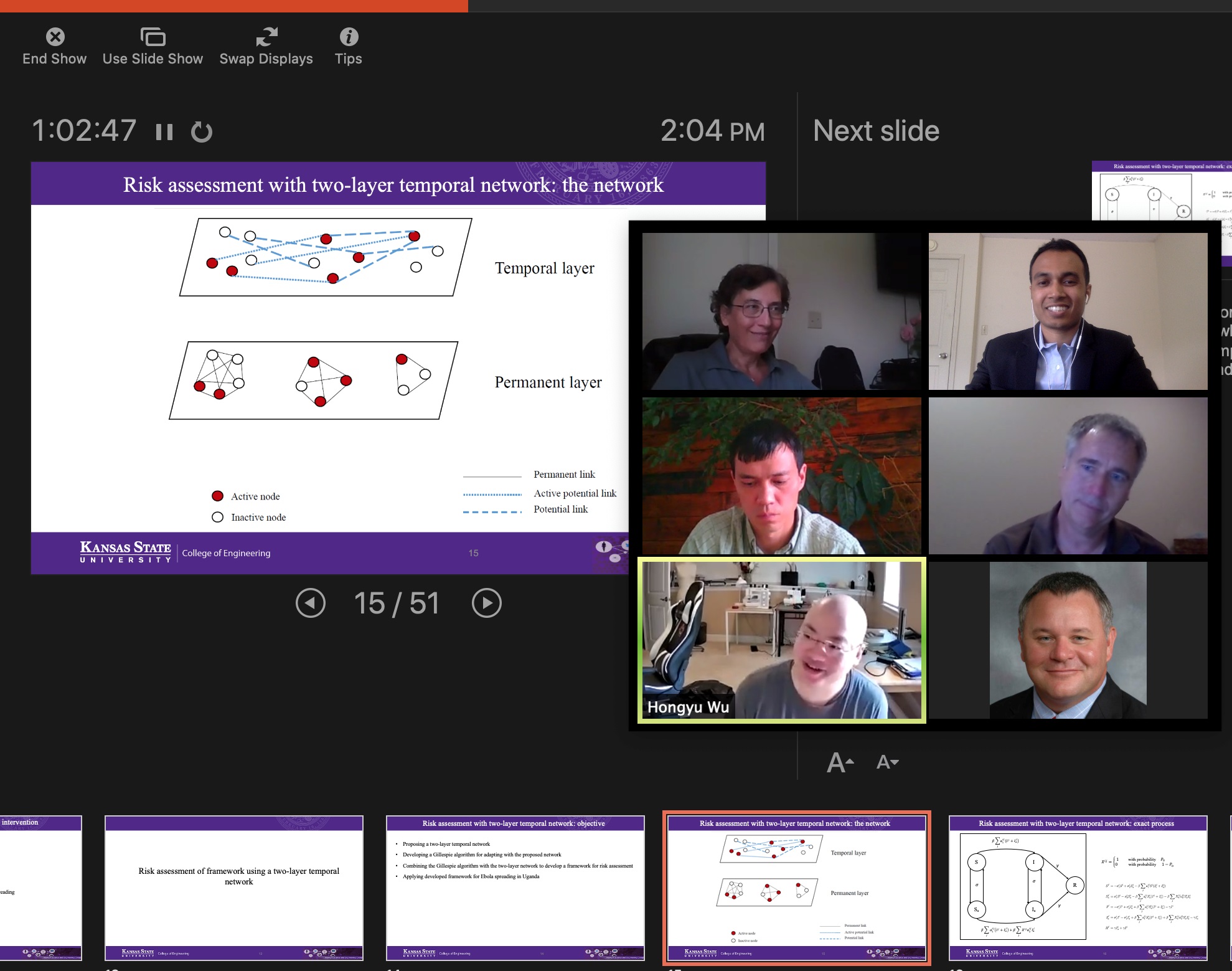
June 1, 2020. Dr. Aram Vajdi joins the NetSE group as a postdoctoral fellow! Congratulations Aram!
May 4, 2020 - Congratulations to Aram Vajdi for defending his Ph.D. dissertation "Stochastic spreading processes on networks" successfully!
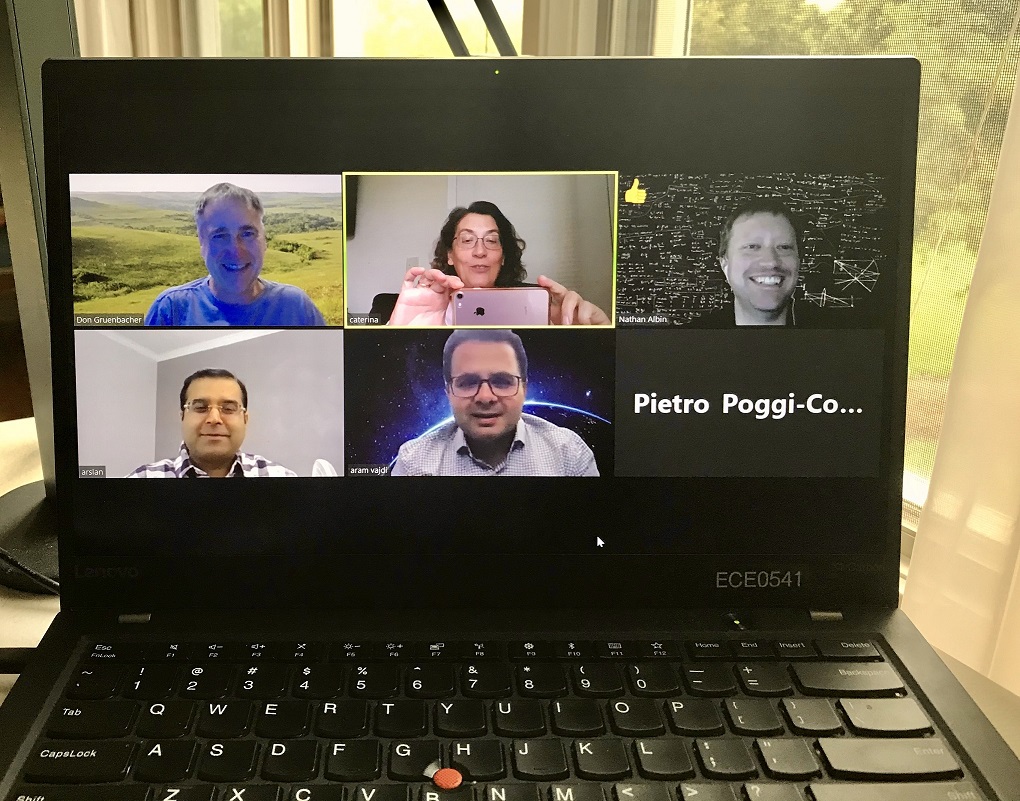
Our work on COVID-19 is now available here:
Modeling the next-day number of cases of COVID-19 in Wuhan City and in China Feb. 22 to Feb 28 2020
Our work is focusing on the prediction of confirmed cases in Wuhan City and in Mainland China. The Ensemble Kalman Filter (EnKF) is used to do estimation and prediction. We model the outbreak disease by a discrete-time Susceptible-Infectious-Removed (SIR) compartmental model, where the transmission rate from Susceptible (S) to Infectious (I) is estimated by the EnKF and the rate from Infectious to Removed (R) is set to 1/10 day-1, which means the average recovery period is 10 days.
For each prediction, the simulation runs 200 iterations and the results are presented as the distribution of these 200 predicted values.
The Team
Chunlin Yi (Ph.D. student), Qihui Yang (Ph.D. student), Aram Vajdi (Ph.D. student), Dr. Lee Cohnstaedt (USDA), Dr. Xiaolong Guo (K-State), Dr. Hongyu Wu (K-State), Dr. Caterina Scoglio (K-State).
Predictions for February 28, 2020
Wuhan City
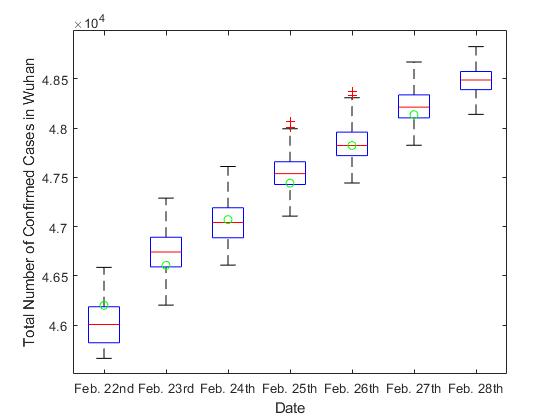
The green circles are the real number of cases on that day and the boxplots are the corresponding forecasts. The last boxplot is the current forecast and the official number will be reported tomorrow.
Mainland China
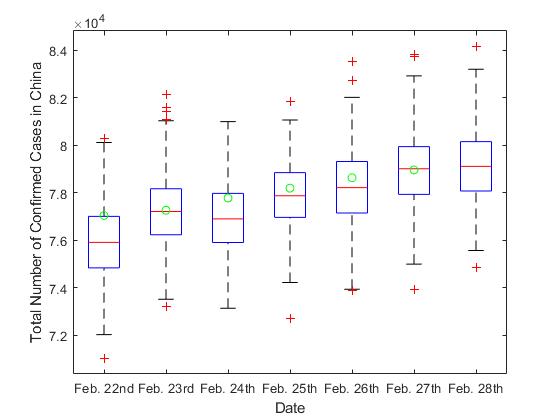
The green circles are the real number of cases on that day and the boxplots are the corresponding forecasts. The last boxplot is the current forecast and the official number will be reported tomorrow.
Prediction for February 15, 2020
China excluded the Hubei Province
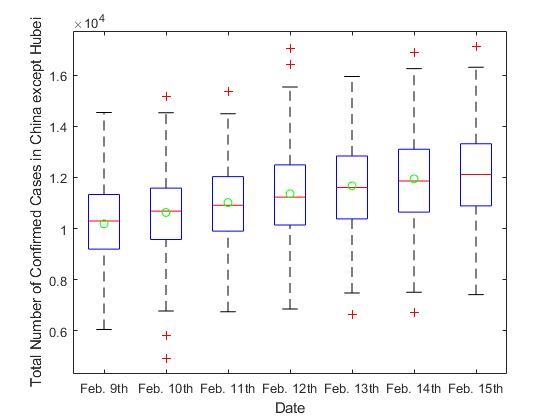
The green circles are the real number of cases on that day and the box-plots are the corresponding forecasts. The last box-plot is the current forecast and the official number will be reported tomorrow.
Aram Vajdi has been selected as the ECE Outstanding Graduate in Research for 2018-2019!
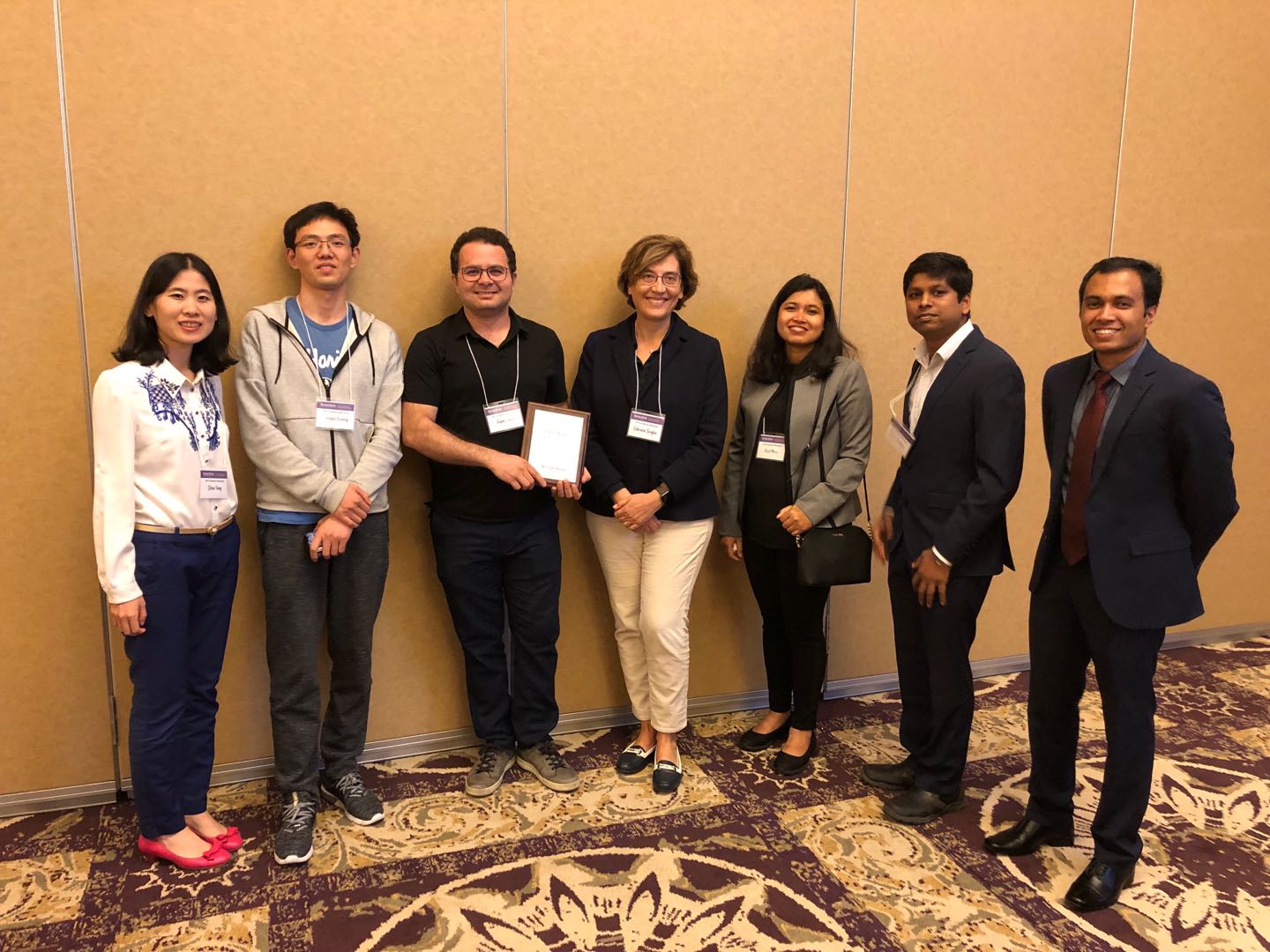
- On Thursday, April 10, 2019, Dr. Ling Xue visited K-State and gave a talk entitled "Mitigating the transmission of Chikungunya, Dengue Fever, and Zika using Wolbachia."
- Wei Sun and Junyao Kuang joined our group in August 2018 as visiting professor and Ph.D. student respectively.
- On Friday, October 13, 2017, Sickweather CEO Graham Dodge visited KState.
- Faryad has been a visiting professor at the Georgia Institute of Technology from July 2016 to August 2017.
- The Workshop on Multilayer and Interconnected Networks in Girona on June 8, 2016, was a success!
- Professor Jose Marzo spent three months May to July 20160 visiting AT the NetSE group.
- Haotian, Xin, Josh, and Futing were the ECE-NetSE Hackathon Team! Hack K-State at hack.cis.ksu.edu. Congrats for their second place!!
- Faryad Darabi Sahneh and Narges Montazeri explained in a video the use contact tracing to isolate everyone who has come into contact with someone sick with a dangerous infectious disease, like Ebola.
- Heman Shakeri has just published a new paper:
H, Shakeri, P. Poggi-Corradini, C. Scoglio, N. Albin
Generalized network measures based on modulus of families of walks
Journal of Computational and Applied Mathematics, Available online 2 February 2016
- Haotian Wu and Xin Li finished 26th internationally out of 2,059 teams in the Oct. 24 IEEEExtreme international programming competition. Read more here.
- Faryad Darabi Sahneh new paper: Exact coupling threshold for structural transition reveals diversified behaviors in interconnected networks

|
|
Haotian Wu and Xin Li
Haotian and Xin presenting their research at 21st GENI Engineering Conference (GEC21) on the IU Bloomington campus October 20-23, 2014 to alumnus Dr. Ali Sydney.
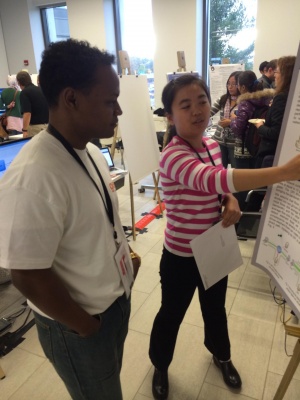
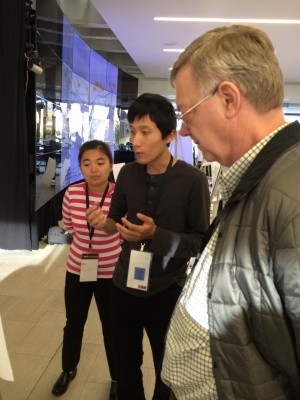
Faryad Darabi Sahneh
Dr. Faryad Darabi Sahneh joins NetSE group as Research Assistant Professor in the Electrical and Computer Engineering Department at Kansas State University!!
Caterina Scoglio
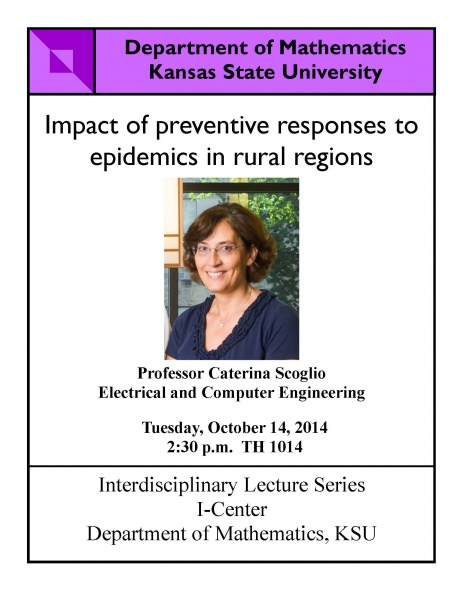
Faryad Darabi Sahneh
Faryad Darabi Sahneh has received the 2014 Award of Excellence in Graduate Research. Congratulations Faryad!! Ad Altiora Semper!
Phil Schumm
Phillip Schumm has received the 2013 Award of Excellence in Graduate Research. Congratulations Phillip!! Ad Altiora Semper!
Caterina Scoglio
Caterina Scoglio is spending a sabbatical year (August 2013-May 2014) as visiting faculty at the INSTITUTE OF COMPUTATIONAL COMPARATIVE MEDICINE (ICCM), Kansas State University, Manhattan KS, directed by Prof. Jim Riviere.
Professor Jose Marzo
Thursday, December 1 2011, 3:30 pm, DUR 1052
Abstract: This talk is mainly focused to the review single and large-scale failures in GMPLS-based networks. Society has come to rely on communications networks for business and leisure and there is high expectation on their availability and performance. Communications networks (or a part there-of) can experience failures, for example due to cables cuts or node breakdowns. These failures usually are not noticed by users thanks to effective protection and recovery mechanisms. Nevertheless, such mechanisms are not effective when large-scale multiple failures arise, that is, when a significant portion of the network fails simultaneously. In this case, in order to minimize their impact a key point is the ability to evaluate the robustness of the network, that is, to be able to assess the performance degradation that should be expected as a consequence of the failure. Robustness metrics have been proposed in the past by the research community. However, our focus is on multilayer networks featur-ing separated control and data planes, as in GMPLS. Thus, the unit of ser-vice is a connection (for example, a light path in an optical network). For this type of networks, most of the existing measures of robustness are unable to capture the real service degradation, due to they essentially rely on purely topological features.
Bio: Jose Marzo is a professor at the Computer Architecture and Technology Department at The University of Girona, Spain. He received his doctorate degree in Industrial Engineering from the University of Girona in 1997. His research interests are in the fields of communication networks, adaptive Hypermedia systems, competences based Curricula design and Quality assessment in distance learning environments. Marzo leads a research group on broadband communications and distributed systems (BCDS) at Informatics and Applications Institute (at the University of Girona)
Research and the State 2011
Congratulations to Sakshi and Sarah!
Sunflower Networking Group members Sakshi Pahwa and Sarah Burress have been nominated to present their posters at the 8th Annual Capitol Graduate Research Summit (CGRS), Topeka KS [1]
In the pictures, Sarah, Dr. Scoglio, and Sakshi.
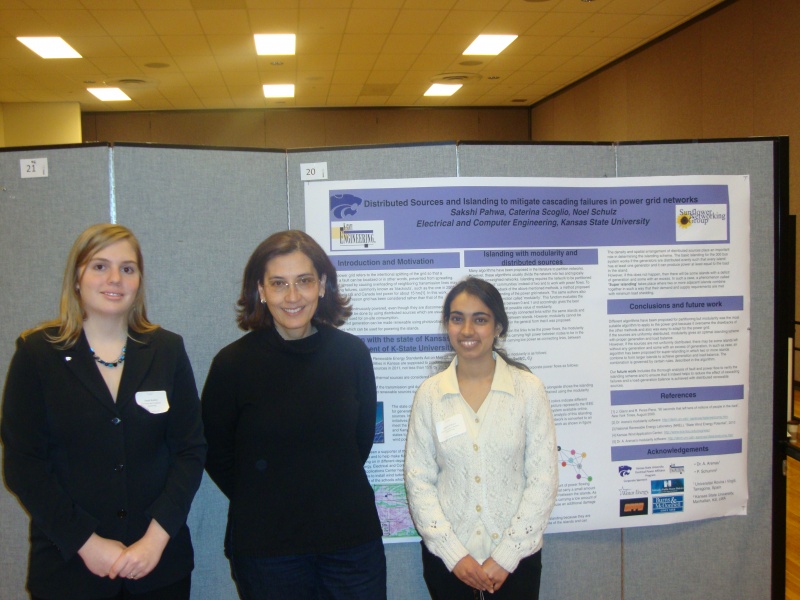
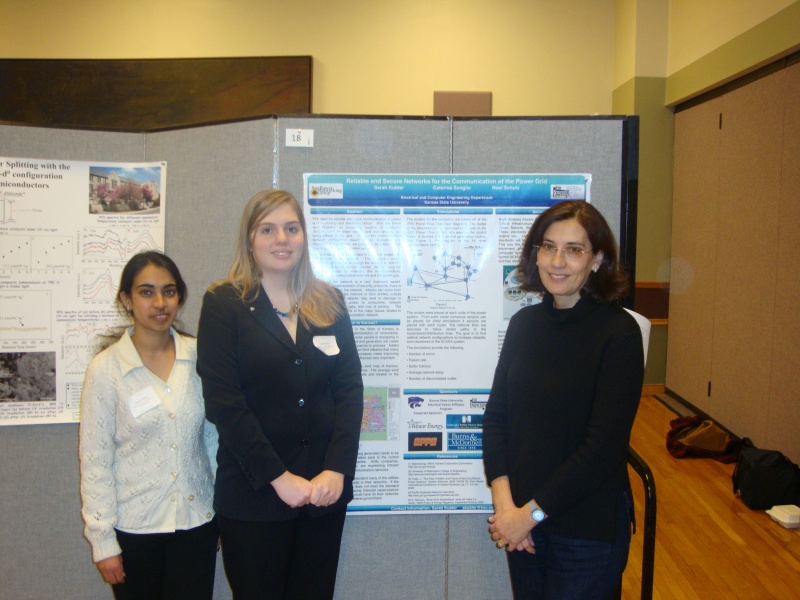
In these pictures, Sakshi is explaining the contents of her poster to Prof. April Mason, provost and senior vice president at Kansas State University.
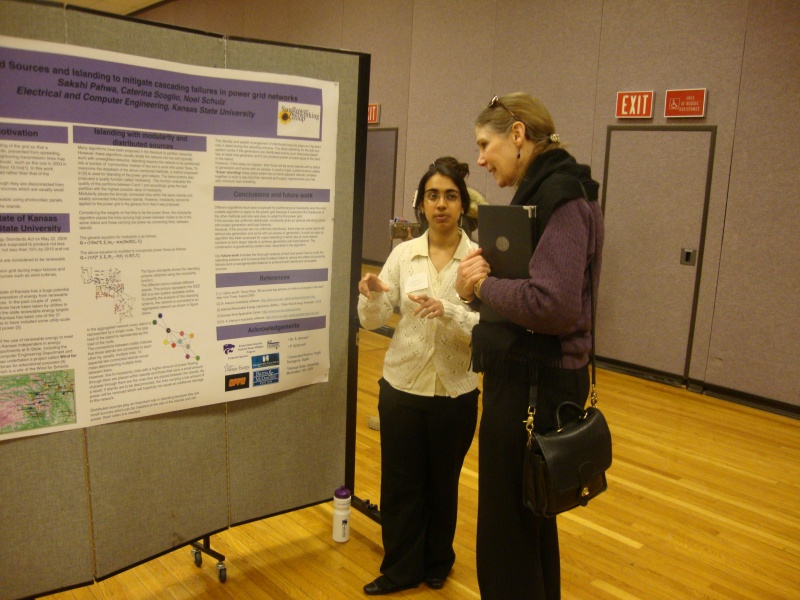
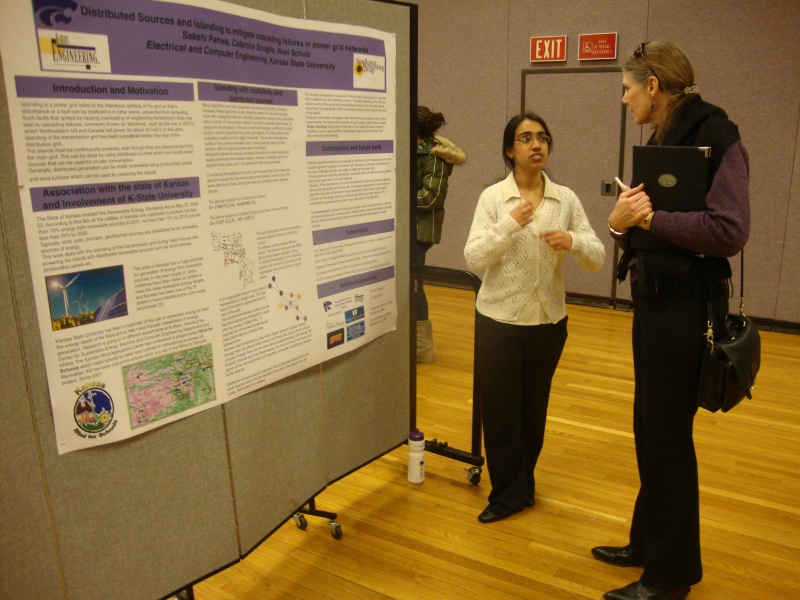
Graduation 2010
Congratulations to Sohini, Ali, Nikkie and Nidhi!
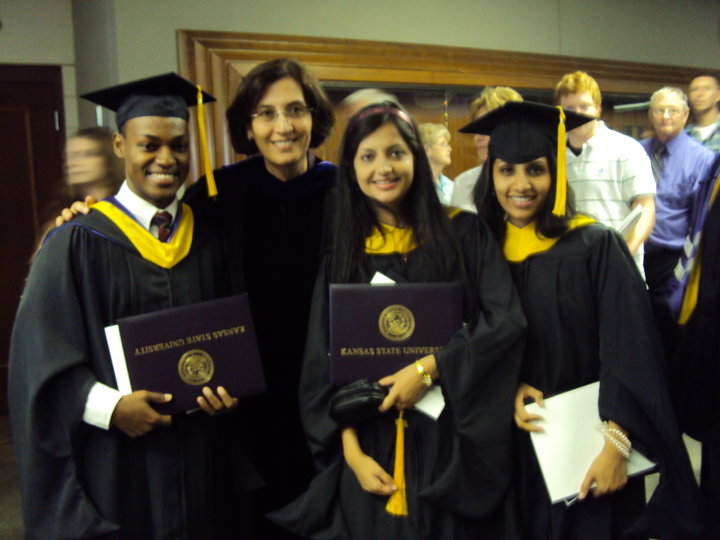
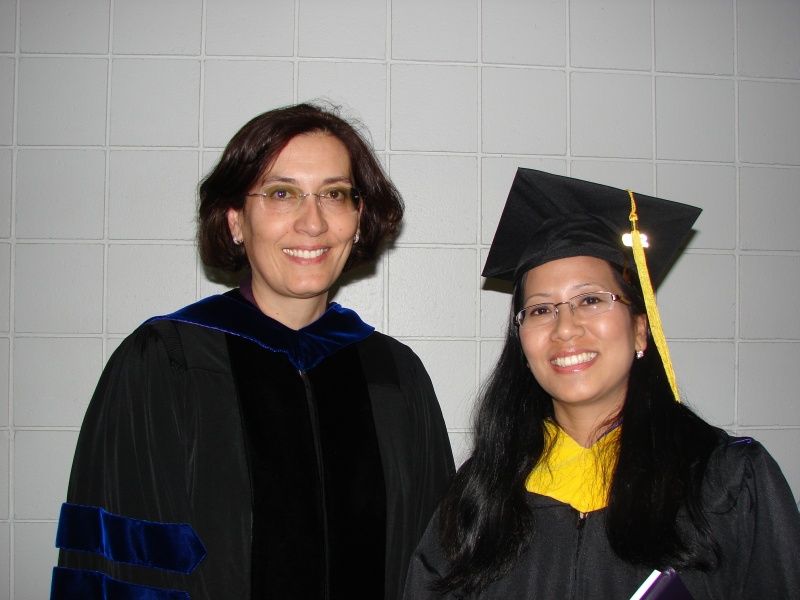
Ben McBride
Ben McBride, former SNG member, presented the ECE Graduate Seminar on "Tamper Resistant Software"
Thursday, November 19, 2009 3:30 p.m. Rathbone Hall 1052
Abstract
Anti‐tamper software techniques are designed to protect trusted code while running in a hostile environment. Proper design of anti‐tamper code, however, requires proper defense of all points in the system. A potential attacker, in contrast has the luxury of focusing attention and resources at a single point. This talk describes a case study of one anti‐tamper system — a system designed to be secure and well‐defended against many attacks but which was actually vulnerable in areas never considered by the designers. This talk will describe the software’s protection mechanisms and the solutions implemented to evade them.
Bio
Ben McBride received his B.S. in Computer Engineering from K-State in 2003. He then went to work for Garmin in the aviation software group where he developed the embedded software for their audio panel product line. In 2005, Ben returned to K-State to pursue a Master's degree with research areas in networking and machine learning. In 2007, Ben received his Master's in Electrical Engineering under the advisement of Dr. Caterina Scoglio. Since then, he has worked in the Embedded Systems Engineering group at Sandia National Labs.
Conferences 2010
- NetSci conference, Boston MA, May 2010
- EpiWork conference, Amsterdam Netherlands, May 2010
- IEEE PES T&D conference and exposition, Louisiana New Orleans, April 2010
- EPI conference, Konza Prairie, Manhattan KS, April 2010
Sakshi
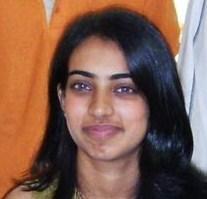
Congratulations to Sakshi for her recent publication in "IEEE 4th International Annual Systems Conference,2010"
Yunzhao
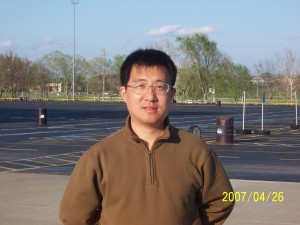
Congratulations to Yunzhao for his recent publication in "NOMS conference Osaka Japan,2010"
Caterina
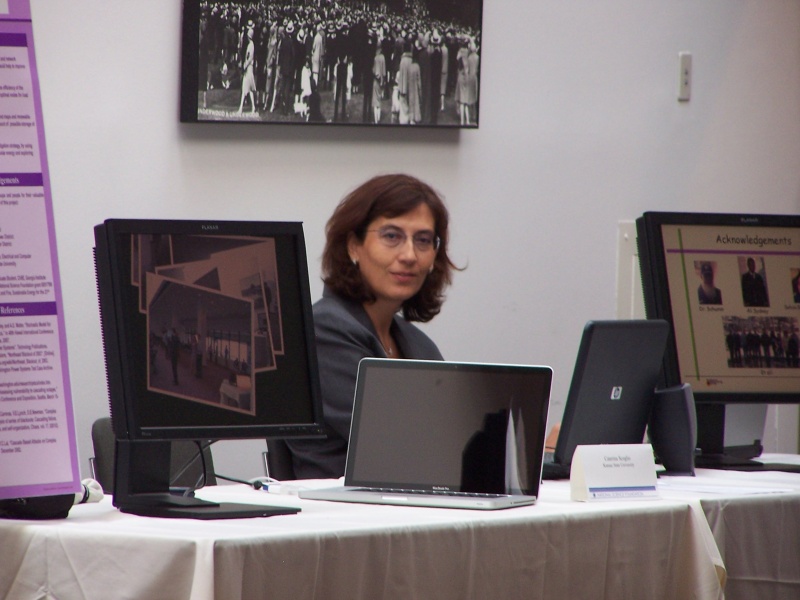
Caterina was invited and participated to the "NSF Future Internet Summit" October 12 - 15 2009.
Sohini
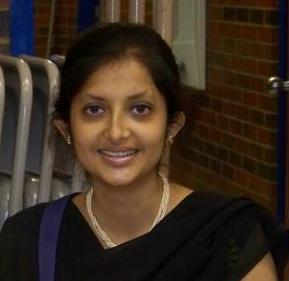
Congratulations to Sohini for her paper accepted in EPIDEMICS², Second International Conference on Infectious Diseases Dynamics, 2009, Athens, Greece. Great job!!
US Senate

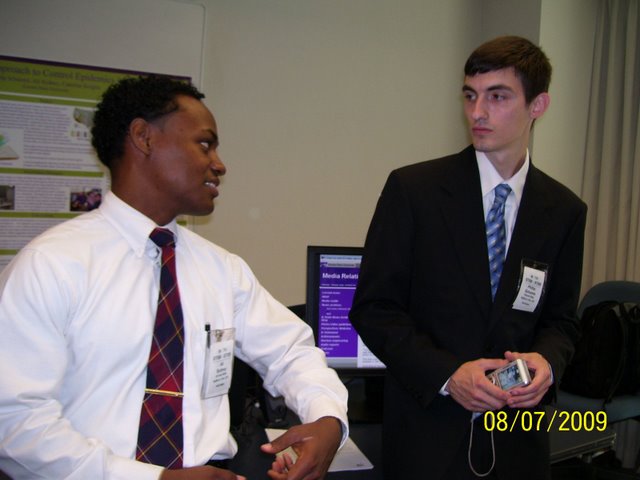
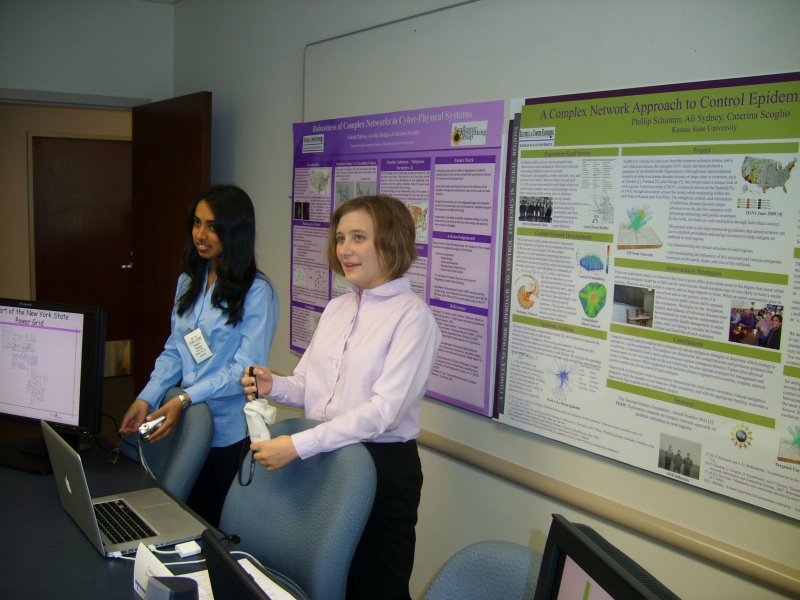
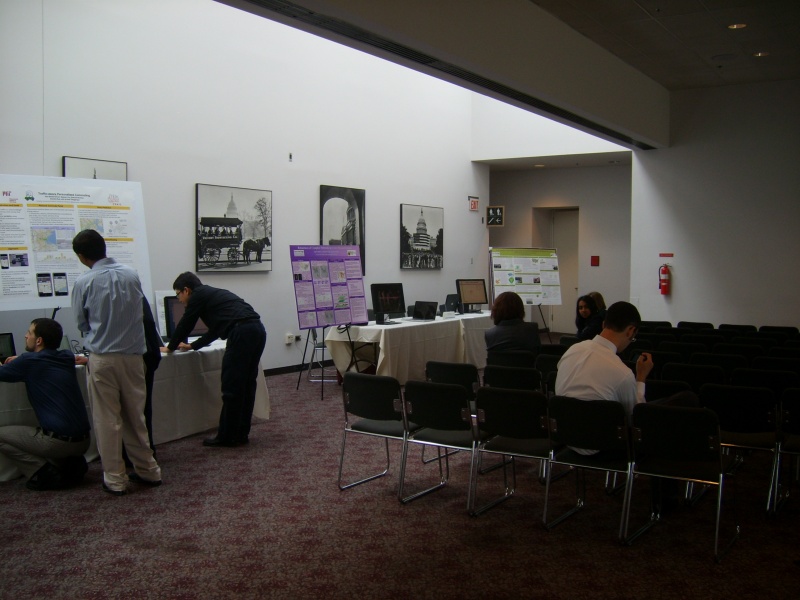
The Sunflower Networking Group was invited to go to Washington DC on July 8 and 9, 2009 for the National Science Foundation (NSF) open-house luncheon briefing on cyber-physical systems (CPS). Held in the Hart Senate Office Building, the luncheon briefing allowed industry and academic experts to share their insights into an area of IT that has been the subject of increasing attention from Congress since a President's Council of Advisors for Science and Technology called it out for increased priority. Great job Phillip, Sakshi, Ali, and Amy!!!
Videos
ADVANCE DISTINGUISHED LECTURE SERIES CANCELED
Dr. Piet F. A. Van Mieghem
Professor
Delft University of Technology
June 29, 2009 10:30 a.m. Fiedler Auditorium 1107
Title: Virus spread in Networks
Abstract: In this presentation, the influence of the network characteristics on the virus spread is analyzed. In particular, our new model, the N-intertwined Markov chain, whose only approximation lies in the application of mean field theory, will be presented. The mean field approximation is quantified in detail. The N-intertwined model has been compared with the exact 2N -state Markov model and with previously proposed “homogeneous” or “local” models. The sharp epidemic threshold Tau_c, which is a consequence of mean field theory, is rigorously shown to be equal to Tau_c = 1 / Lambda_max(A), where Lambda_max(A) is the largest eigenvalue – the spectral radius – of the adjacency matrix A. A continued fraction expansion of the steady-state infection probability at node j is presented, as well as several upperbounds. Some concepts from algebraic graph theory, such as algebraic connectivity and isoperimetric constant, will also be introduced to explain our understanding.
Bio: Piet F. A. Van Mieghem is professor at the Delft University of Technology with a chair in telecommunication networks and chairman of the section Network Architectures and Services (NAS). His main research interests lie in new Internet-like architectures for future, broadband and QoS-aware networks and in the modelling and performance analysis of network behavior and complex infrastructures. Professor Van Mieghem received a Master's and Ph. D. in Electrical Engineering from the K.U. Leuven (Belgium) in 1987 and 1991, respectively. Before joining Delft, he worked at the Interuniversity Micro Electronic Center (IMEC) from 1987 to 1991. During 1993 to 1998, he was a member of the Alcatel Corporate Research Center in Antwerp where he was engaged in performance analysis of ATM systems and in network architectural concepts of both ATM networks (PNNI) and the Internet. He was a visiting scientist at MIT (department of Electrical Engineering, 1992-1993) and, in 2005, he was visiting professor at UCLA (department of Electrical Engineering). He was member of the editorial board of the journal Computer Networks from 2005-2006. Currently, he serves on the editorial board of the IEEE/ACM Transactions on Networking.
ADVANCE DISTINGUISHED LECTURE SERIES
Dr. Mark Newman, Professor of Physics,
University of Michigan
September 4 2008
Epidemics, Erdos numbers, and the Internet: The structure and function of complex networks
There are networks in almost every part of our lives. Some of them are familiar and obvious: the Internet, the power grid, the road network. Others are less obvious but just as important: the patterns of friendships or acquaintances between people form a social network; the species in an ecosystem join together to form a food web; the workings of the body's cells are dictated by a metabolic network of chemical reactions. As large-scale data on these networks and others have become available in the last few years, a new science of networks has grown up, drawing on ideas from math, engineering, biology, physics and other fields to shed light on systems ranging from bacteria to the whole of human society. This lecture will look at some new discoveries regarding networks, how these discoveries were made, and what they can tell us about the way the world works.
Mark Newman received his Ph.D. in physics from the University of Oxford in 1991 and, after postdoctoral work at Cornell University, joined the staff of the Santa Fe Institute in New Mexico, a think-tank devoted to the study of complex systems. In 2002 he left Santa Fe to move to the University of Michigan in Ann Arbor. He is currently the Paul A. M. Dirac Professor of Physics at the University of Michigan as well as a professor in the university's Center for the Study of Complex Systems.
Professor Newman's research is on networks, including computer networks and social networks, and he has worked on topics as diverse as the spread of computer viruses on the Internet, the spread of human diseases over social networks, the pattern of collaborations between scientists in different fields, and the networks formed by committees in the US House of Representatives.
Dr. Mark Newman lecture at K-State on "Epidemics, Erdos numbers, and the Internet: The structure and function of complex networks".
Master Thesis Defense of Mina Youssef
DATE: Friday, November 30th, 2007 TIME: 1:30 pm VENUE: EECE Dept conference room TITLE: OPTIMAL TOPOLOGY DESIGN FOR VIRTUAL NETWORKS
THE NABC FORUM
DATE: Thursday, August 2, 2007 TIME: 9:00 am. VENUE: KSU Union, Room 212
AGENDA:
9:00 - 9:10 | Introductory comments by Drs. Marty Vanier and Curtis Kastner
9:10 - 10:00 | Controlling Epidemic Outbreaks through Modeling, Analysis, and Optimization of Complex Networks:
by Dr. Caterina Scoglio, Dr. Todd Easton, Dr. Don Gruenbacher, and Phillip Schumm.
10:00 | Questions
Dr. Tricha Anjali is coming to visit our group from March 5, 2007 to March 9 2007.
Thanks to the NSF ADVANCE program that is supporting the travel expenses for this visit.
ADVANCE DISTINGUISHED LECTURE SERIES
Dr. Jennifer Rexford, Professor
Department of Computer Science, Princeton University
Title: GENI: Global Environment for Network Innovations
Date: March 8, 2007
Time: 3:30 PM
Location: 1107 Fiedler Auditorium, Fiedler Hall, Kansas State University, Manhattan KS
ABSTRACT: Despite its tremendous success, the Internet architecture is showing its age. Security is weak and the problems are worsening; availability continues to be a challenge; network management is complex and expensive; and mobile hosts are difficult to handle. Yet, researchers interested in designing new network architectures face an unfortunate catch-22. New ideas are not likely to see significant adoption without evaluation of prototype systems under realistic conditions, and yet deploying a prototype in a production network is difficult without first demonstrating the value. The GENI initiative at the U.S. National Science Foundation aims to break this cycle by providing the networking research community with a controlled and realistic environment to evaluate new network architectures. This talk will provide an overview of GENI and its three main features---virtualization, programmability, and user opt-in---as well as the current thinking about the design of the various components.
BIO: Jennifer Rexford is a Professor in the Computer Science department at Princeton University. From 1996-2004, she was a member of the Network Management and Performance Department at AT&T Labs--Research. Her research focuses on Internet routing, network measurement, and network management, with the larger goal of making data networks easier to design, understand, and manage. Jennifer is co-author of the book "Web Protocols and Practice" (Addison-Wesley, May 2001). Jennifer serves as the chair of ACM SIGCOMM and a member the CRA Board of Directors. She received her BSE degree in electrical engineering from Princeton University in 1991, and her MSE and PhD degrees in computer science and electrical engineering from the University of Michigan in 1993 and 1996, respectively. She was the winner of ACM's Grace Murray Hopper Award for outstanding young computer professional of the year for 2004.
Visit Itinerary for Jennifer Rexford
9:00 Meeting1 (FIND Proposal: Caterina, Tricha) 10:00 Student Presentations (Ben, Mina, Supriya, Chris) 11:30 Networking Course EECE841 (Lecture by Jennifer on Internet Topology Measur.) 12:30 Lunch: Jennifer and women students in science and engineering (Harry's) 14:00 Meeting2 (Resilient Networks: James Sterbenz, University of Kansas) 15:30 Advance Distinguished Lecture, Fiedler 1107 (Presentation by Jennifer on GENI) 17:00 Meeting3 (Traffic Measurement and Modelling: Caterina and Tricha) 18:30 Dinner: Houlihan's (Jennifer, Anil, Tricha,Caterina, Ben, Amber)
